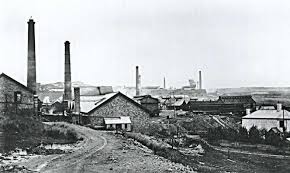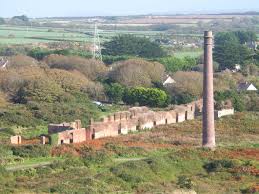The Birth of the Dynamite Factory
The Towans, a stunning stretch of sand dunes along the coast of Hayle in Cornwall, are known for their natural beauty and rich history. Among the many historical treasures hidden within the Towans is the site of an old dynamite factory. This blog post delves into the fascinating history of this factory, the trade of dynamite, and the impact it had on the local area.

The Need for Dynamite:
In the late 19th and early 20th centuries, the industrial revolution and the expansion of mining operations in Cornwall created a high demand for explosives. Dynamite, invented by Alfred Nobel in 1867, quickly became the explosive of choice due to its stability and power. It was used extensively in mining, quarrying, and construction projects.
Establishment of the Factory:
The dynamite factory in the Towans was established in the late 19th century by the National Explosives Company. The location was chosen for its isolation, which minimised the risk to populated areas in case of an accident. The factory was strategically placed among the dunes to provide natural protection and concealment.
The Towans provided an ideal environment for such an operation. The sprawling sand dunes offered a buffer against potential explosions, and the remote location ensured that any accidents would pose minimal risk to local residents.
The Operation of the Factory

Production Processes:
The production of dynamite involved several complex and hazardous processes. Nitroglycerin, the primary explosive component, was mixed with an absorbent material such as diatomaceous earth to create a stable product. This mixture was then packed into cartridges for use in mining and construction.
The factory was divided into several sections, each responsible for a different stage of production. These included the mixing houses, where the dangerous task of combining nitroglycerin with the absorbent material took place, and the packing houses, where the final product was prepared for distribution.
Safety Measures:
Given the volatile nature of the materials involved, safety was a paramount concern at the factory. Workers were required to wear special clothing to prevent static electricity, and strict protocols were in place to minimize the risk of accidents. Despite these precautions, the inherent dangers of handling explosives meant that accidents were not uncommon.
The Workforce:
The factory employed a significant number of local residents, providing much-needed jobs in the area. However, working at the factory was perilous, and workers had to be extremely careful to avoid triggering explosions. The workforce included both men and women, with women often employed in less physically demanding roles such as packing and quality control.

The Trade of Dynamite
Local and Global Impact:
The dynamite produced at the Towans factory played a crucial role in local mining operations, facilitating the extraction of tin and copper, which were vital to Cornwall’s economy. However, the impact of the dynamite trade extended far beyond the local area.
Dynamite from the Towans was exported globally, contributing to mining and construction projects around the world. The factory’s output helped to fuel the industrial growth of the late 19th and early 20th centuries, providing the explosive power needed to build railways, tunnels, and other infrastructure.
Transportation and Distribution:
The finished dynamite was transported from the factory to various destinations via a network of roads and railways. Special precautions were taken during transportation to ensure the safe handling of the explosives. The factory had its own railway siding, connecting it to the mainline and facilitating the efficient movement of goods.
Decline and Legacy
The End of Production:
The demand for dynamite began to decline in the mid-20th century, as new explosives and mining techniques were developed. Additionally, increasing safety regulations and environmental concerns made the production of dynamite more challenging. The Towans factory eventually closed its doors in the early 20th century, marking the end of an era.
The Legacy of the Factory
Today, the remnants of the dynamite factory can still be found within the Towans, offering a glimpse into Cornwall’s industrial past. The site has become an important historical landmark, attracting visitors and researchers interested in the region’s history.
Conservation and Education:
Efforts have been made to preserve the site and educate the public about its historical significance. Information boards and guided tours provide insights into the factory’s operation and the lives of the people who worked there. The site also serves as a reminder of the dangers faced by workers in the past and the advancements in safety and technology that have since been made.
Visiting the Old Dynamite Factory

How to Get There:
The old dynamite factory is located within the Towans, a large area of sand dunes near Hayle. The site is accessible by foot, with several walking trails leading through the dunes. The nearest car park is at Gwithian Towans, from where it is a short walk to the factory site. The carpark is also located a short walk from our beach-side base by where you can Hire Surf Equipment or Learn to Surf from the best beach in the country. Check out the official write up from The Times’ HERE.
What to Expect:
Visitors to the site can explore the remnants of the factory, including the ruins of buildings and machinery. Information boards provide historical context and details about the production processes and safety measures. The surrounding dunes offer stunning views and a chance to experience the natural beauty of the area.
Safety Considerations:
While visiting the site, it’s important to stay on marked paths and follow any safety guidelines provided. The area is protected, and visitors are encouraged to respect the environment and preserve the historical integrity of the site.
The Power of Industrial Innovation
The old dynamite factory in the Towans is a fascinating historical site that offers a unique insight into Cornwall’s industrial heritage. From its establishment in the late 19th century to its eventual decline, the factory played a significant role in the local economy and the global trade of dynamite. Today, it stands as a testament to the ingenuity and resilience of the people who worked there, as well as a reminder of the transformative power of industrial innovation.
Whether you’re a history enthusiast, a nature lover, or simply curious about Cornwall’s past, a visit to the old dynamite factory in the Towans is sure to be a rewarding experience. Explore the site, learn about its history, and appreciate the beauty and complexity of this remarkable location.



